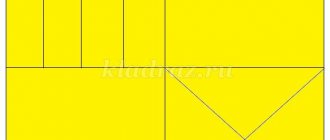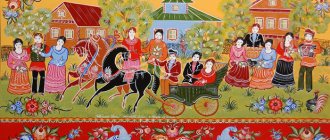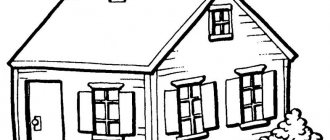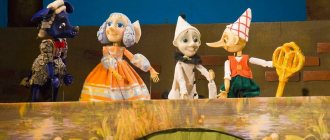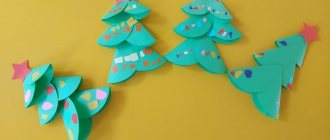A technique for familiarizing yourself with the composition of a number from two smaller numbers and the decomposition of a number into two smaller ones.
In terms of preparing children for the activity of calculation, it is necessary to introduce them to the composition of a number from 2 smaller numbers. This task is considered one of the most important
in preparing
children for
computing activities.
Children are introduced not only to decomposing a number into 2 smaller numbers, but also to obtaining a number from 2 smaller numbers. This helps children understand the features of a sum as a conditional combination of 2 terms.
Children are shown all the options for the composition of numbers within the heel.
The number 2 is 1 and 1,
3 is 2 and 1, 1 and 2,
4 is 3 and 1, 2 and 2, 1 and 3,
5 is 4 and 1, 3 and 2, 2 and 3, 1 and 4.
PREPARATORY WORK:
operations with sets of objects, creating a set from a subset, dividing sets into subsets, comparing them with each other.
PRIMARY GOAL
: Children's awareness of how a number can be formed from other numbers by analyzing how a set can be formed from parts.
MATERIAL
: discrete quantities, geometric figures, objects.
REQUIREMENTS:
- gradualism (start with numbers 3, 4.5...),
- do not memorize the composition, but teach to understand the method of action,
- use subject, symbolic, verbal and graphic models,
- show ALL possible options for decomposing a number into two smaller ones (using the formula n-1, where n is a natural number).
WORK METHODS
(for number 3)
The teacher lays out 3 circles of the same color in a row on a typesetting canvas, asks the children to say how many circles there are, and indicates that in this case the group is made up of 3 red circles: 1, 1 and 1 more. “A group of 3 circles can be made up differently,” says the teacher and turns the third circle back. “How is the group composed now?” - asks the teacher. Children answer that the group is made up of 2 red circles and 1 blue circle, and in total - of 3 multi-colored circles.
The teacher concludes that the number 3 can be made up of the numbers 2 and 1, and 2 and 1 together make 3. Then he turns the second circle back, and the children tell him that the group is now made up of 1 red and 2 blue circles. Summarizing the children's answers in conclusion, the teacher emphasizes that the number 3 can be composed in different ways: from 2 and 1, from 1 and 2. This exercise clearly reveals the composition of the number, the relationship between the whole and the part, so it is advisable to begin introducing children to the composition of numbers with it .
(for number 5):
1.
The teacher lays out 5 circles of the same color, on the reverse side the circles have a different color (for example, red and blue). Find out how many circles there are and how they are similar.
Turn over the first circle, clarify: how many blue ones? how many red? how many circles are there in total? How many blue and red circles did you take to make 5 in total? Find out how the number 5 came about:
1 yes 4, 2 yes 3, 3 yes 2, 4 yes 1
2.
The bear asked the bear cub to bring 5 mushrooms from the forest. These should be boletus and porcini mushrooms. Show how the little bear can make a group of these mushrooms.
3.
5 flowers should be planted in 4 flower beds, and roses and tulips should grow in one flower bed. How can this be done differently?
4.
Arrange 5 pyramids on two shelves. How can I do that? (2.3; 3.2; 4.1; 1.4)
——————— ——————————
—————————— ——————————-
———————————— —————————————-
————————————— ——————————————-
5.
Divide 5 pencils between two children. In how many ways can this be done? (four)
6.
I have 5 buttons in both hands.
How many buttons can there be in each hand? If there are 3 on the right, then how many on the left? (two) (children perform this task based on clear ideas about the composition of the number 5; if there is difficulty, suggest using an object model, for example, sticks, in order to restore the decomposition option: count 5 sticks , put 3 aside and see how many are left in the other group).
7.
Working with number figures: there are only 5 circles on the card, how many can you see? How many did I close? (three)
8.
Divide 5 triangles into two groups in different ways: (1.4; 2.3; 3.2; 4.1)
9.
Fill in the empty circles, “houses”: (2 in the circle and 1.4; 2.3 in the table)
| 5 | |
| 1 | |
| 3 | |
5
10.
Circle the numbers that make up the number 5:
1, 4, 3, 4, 1, 5, 2, 4, 1, 3, 2
Sample:
1, 4 3, 4, 1, 5, 2, 4, 1, 3, 2
To consolidate children's knowledge about the composition of a number from 2 smaller numbers
use a variety of
exercises with objects and models of geometric shapes
.
Children are offered story-challenges
, For example:
“There were 3 swallows sitting on the top wire, 1 swallow moved to the bottom wire. How many swallows are there in total? How are they sitting now? How can they still sit?” (Swallows on the typesetting canvas are transplanted from wire to wire.)
Or: “Vera was given 4 pencils. She shared with Anya. How could she separate the pencils?
Tasks are given for the same purpose.
: one child take 3 pebbles (acorns) in both hands, and the rest guess how many pebbles he has in each hand; divide a group of 3 (4, 5) toys between 2 children; draw 2 types of shapes, for example circles and squares, 4 shapes in total; It is useful to look at number figures with children, in which the circles are divided into 2 groups.
Having completed one or another task, each time the children talk about what 2 groups the set is divided into, how many objects are included in it, and make a generalization about the composition of the number from 2 smaller numbers. For example, a child says: “I took 2 green and 1 yellow ribbon, and there are 3 ribbons in total. The number 3 can be made from 2 and 1; 2 and 1 together make 3."
It is important to teach children to construct answers differently
: go both from the particular to the general and from the general to the particular: “In total, I drew 4 shapes: 3 squares and 1 oval shape.”
It is equally important to encourage children to establish a relationship between the whole and the parts, that is, to draw a conclusion about the composition of the number: “The number 4 can be made from 3 and 1; 3 and 1 together make 4."
To bring children to a generalization
they are given
the following tasks
: the teacher shows a card on which from 3 to 5 objects are depicted, but he closes some of them and says: “There are 4 bunnies drawn on the card. Guess how many bunnies I closed.”
The teacher takes 2 number figures, shows one of them, for example with 3 circles, to the children, and turns the second one to them with the reverse side and asks: “How many circles are on an inverted card, if there are 5 circles on 2 cards together? How did you guess?
You can encourage children to find examples in the group room of dividing numbers into 2 groups.
. For example, in a group room there may be 2 cabinets with toys and 1 with manuals, but 3 cabinets in total; 2 big bears and 3 small ones, for a total of 5 bears, etc.
Familiarity with the composition of a number from 2 smaller numbers provides the transition to teaching children to calculate.
We will help you write any paper on a similar topic.
- Essay
A technique for familiarizing yourself with the composition of a number from two smaller numbers and the decomposition of a number into two smaller ones.
From 250 rub.
- Test
A technique for familiarizing yourself with the composition of a number from two smaller numbers and the decomposition of a number into two smaller ones.
From 250 rub.
- Course work
A technique for familiarizing yourself with the composition of a number from two smaller numbers and the decomposition of a number into two smaller ones.
From 700 rub.
Receive completed work or specialist advice on your educational project
Find out the cost
